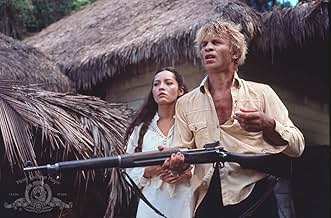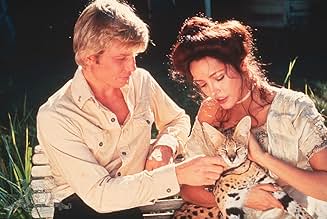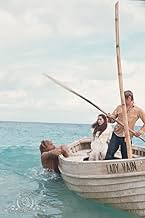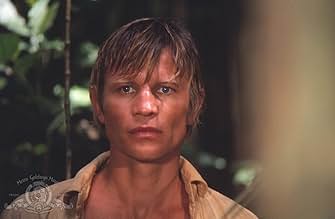VALUTAZIONE IMDb
5,9/10
7681
LA TUA VALUTAZIONE
Aggiungi una trama nella tua linguaA shipwrecked survivor discovers a remote island owned by a crazed scientist who is carrying out sinister experiments on the island's inhabitants.A shipwrecked survivor discovers a remote island owned by a crazed scientist who is carrying out sinister experiments on the island's inhabitants.A shipwrecked survivor discovers a remote island owned by a crazed scientist who is carrying out sinister experiments on the island's inhabitants.
- Regia
- Sceneggiatura
- Star
- Premi
- 6 candidature totali
Recensioni in evidenza
... although any limitations on what could have been shown or done were much more lax in this film 44 years later. Yet I just like the original better.
This is another take on the H. G. Wells novel about the "mad" scientist experimenting with animals on a South Seas island, performing surgery on them in "the House of Pain" to try to transform them into human beings. Of course, things never go as planned in these films. Moreau is, after all, "tampering in God's domain" (though that hoary old expression is mercifully not used in this film).
Difficult to not compare this version to the first adaption, 1933's Island of Lost Souls, which I find far more satisfactory. In the original Charles Laughton brought a creepy, perverse quality to his Moreau. He was unsettling but effective, and when he cracked that whip in the "What is the law?" scene with the man beasts there was more than a hint of the sadist about him.
The surprising casting of Burt Lancaster as Moreau in the 1977 version fails to bring any of these same odious qualities to the film. It's difficult to work up much of a dislike for Lancaster's scientist in spite of his activities. He's still Burt, and he has to battle against his good guy screen persona.
Island of Dr. Moreau also surprisingly jettisons one of the kinkiest aspects of the 1933 film, the Panther Girl, as originally played by Kathleen Burke, his most near perfection human like creation from a beast, with whom Laughton's Moreau is eager to see if an unsuspecting male shipwrecked on his island (Richard Arlen) will be willing to mate.
The '77 version does have beautiful Barbara Carrera slinking around, and she certainly intrigues (well, more than intrigues) Michael York, now in the Arlen role. Lancaster is aware that they are sexually attracted to each other and ready to mate - but to what purpose, since it turns out Carrera is a normal human, and no kind of Panther Girl. There is a hint in her final scene, however, that she may not be quite so normal, after all, but it went by so quickly I wasn't quite certain if it was my imagination.
The man beasts in the original are more effective than here. For starters, you didn't get a really good look at the makeup in the original (outside of a closeup of Bela Lugosi), so much of it is left to the audience's imagination. In the '77 version you see the makeup and, to be honest, it's not so much frightening as it is artificial in appearance (on about a par with that to be found in the original Planet of the Apes).
The '77 version, however, interestingly, does show what happens to the man beasts after everything blows up on the island, something the '33 original left to our imagination. This version also has Moreau strapping down and experimenting with York, something not done in the '33 version. That is one of the more interesting aspects of this production, as well.
In the final analysis, this is a fairly mediocre adaption of the Wells story, but one should still see it to make his own assessment. There would be another version with Brando almost 20 years later, of course. It's been too long since I've seen that version to talk about it, though I do recall disliking it at the time.
This is another take on the H. G. Wells novel about the "mad" scientist experimenting with animals on a South Seas island, performing surgery on them in "the House of Pain" to try to transform them into human beings. Of course, things never go as planned in these films. Moreau is, after all, "tampering in God's domain" (though that hoary old expression is mercifully not used in this film).
Difficult to not compare this version to the first adaption, 1933's Island of Lost Souls, which I find far more satisfactory. In the original Charles Laughton brought a creepy, perverse quality to his Moreau. He was unsettling but effective, and when he cracked that whip in the "What is the law?" scene with the man beasts there was more than a hint of the sadist about him.
The surprising casting of Burt Lancaster as Moreau in the 1977 version fails to bring any of these same odious qualities to the film. It's difficult to work up much of a dislike for Lancaster's scientist in spite of his activities. He's still Burt, and he has to battle against his good guy screen persona.
Island of Dr. Moreau also surprisingly jettisons one of the kinkiest aspects of the 1933 film, the Panther Girl, as originally played by Kathleen Burke, his most near perfection human like creation from a beast, with whom Laughton's Moreau is eager to see if an unsuspecting male shipwrecked on his island (Richard Arlen) will be willing to mate.
The '77 version does have beautiful Barbara Carrera slinking around, and she certainly intrigues (well, more than intrigues) Michael York, now in the Arlen role. Lancaster is aware that they are sexually attracted to each other and ready to mate - but to what purpose, since it turns out Carrera is a normal human, and no kind of Panther Girl. There is a hint in her final scene, however, that she may not be quite so normal, after all, but it went by so quickly I wasn't quite certain if it was my imagination.
The man beasts in the original are more effective than here. For starters, you didn't get a really good look at the makeup in the original (outside of a closeup of Bela Lugosi), so much of it is left to the audience's imagination. In the '77 version you see the makeup and, to be honest, it's not so much frightening as it is artificial in appearance (on about a par with that to be found in the original Planet of the Apes).
The '77 version, however, interestingly, does show what happens to the man beasts after everything blows up on the island, something the '33 original left to our imagination. This version also has Moreau strapping down and experimenting with York, something not done in the '33 version. That is one of the more interesting aspects of this production, as well.
In the final analysis, this is a fairly mediocre adaption of the Wells story, but one should still see it to make his own assessment. There would be another version with Brando almost 20 years later, of course. It's been too long since I've seen that version to talk about it, though I do recall disliking it at the time.
The Island of Dr. Moreau (1977)
** 1/2 (out of 4)
Andrew Braddock (Michael York) shipwrecks and eventually washes up on a jungle island. Once there he is introduced to Dr. Moreau (Burt Lancaster) who at first seems like a nice guy simply doing research. Pretty soon Andrew begins to realize that the doctor is doing strange experiments between men and animals and the result are some mutated creatures living in the jungle.
Whenever people speak about the H.G. Wells adaptations of this story, it seems this one here is forgotten and sometimes it doesn't even come up. Of course, they always discuss the greatness of 1932's ISLAND OF LOST SOULS and they always discuss the disastrous Marlon Brando version. Why is this film from 1977 rarely mentioned? I'm going to guess because it's not really a flat-out horror movie. The majority of its running time it appears to be trying to be a real medical drama and a showcase for Lancaster.
Is that a bad thing? I personally don't think so but it does make for a rather slow running time and I'm sure some people would have preferred more horror elements or more of a spotlight being placed on the creatures. With that said, I think this is a mildly entertaining movie thanks in large part to the performances in the film. Lancaster always carried himself with such grace that he had no problem fitting into this role to where people could see this character and think that he was a good man. I thought Lancaster was good in the part, although the screenplay never really allowed him a chance to go crazy or mad.
York was also good in the lead role, although his character too suffers from not getting too much to do until the very end. Nigel Davenport is good in the supporting role as the doctor's help and Barbara Carrera made for a good love interest. Richard Basehart got to play the role originated by Bela Lugosi and I couldn't help but think that Basehart had seen the earlier version and remembered Lugosi's performance.
With all of that said, the film really does come to life during the final fifteen-minutes once the creatures decide that they have had enough. I thought the various animals that were used were great and I also thought the action was nice. There were some tense moments that happened during the final action sequence so overall the film at least goes out on a good note.
** 1/2 (out of 4)
Andrew Braddock (Michael York) shipwrecks and eventually washes up on a jungle island. Once there he is introduced to Dr. Moreau (Burt Lancaster) who at first seems like a nice guy simply doing research. Pretty soon Andrew begins to realize that the doctor is doing strange experiments between men and animals and the result are some mutated creatures living in the jungle.
Whenever people speak about the H.G. Wells adaptations of this story, it seems this one here is forgotten and sometimes it doesn't even come up. Of course, they always discuss the greatness of 1932's ISLAND OF LOST SOULS and they always discuss the disastrous Marlon Brando version. Why is this film from 1977 rarely mentioned? I'm going to guess because it's not really a flat-out horror movie. The majority of its running time it appears to be trying to be a real medical drama and a showcase for Lancaster.
Is that a bad thing? I personally don't think so but it does make for a rather slow running time and I'm sure some people would have preferred more horror elements or more of a spotlight being placed on the creatures. With that said, I think this is a mildly entertaining movie thanks in large part to the performances in the film. Lancaster always carried himself with such grace that he had no problem fitting into this role to where people could see this character and think that he was a good man. I thought Lancaster was good in the part, although the screenplay never really allowed him a chance to go crazy or mad.
York was also good in the lead role, although his character too suffers from not getting too much to do until the very end. Nigel Davenport is good in the supporting role as the doctor's help and Barbara Carrera made for a good love interest. Richard Basehart got to play the role originated by Bela Lugosi and I couldn't help but think that Basehart had seen the earlier version and remembered Lugosi's performance.
With all of that said, the film really does come to life during the final fifteen-minutes once the creatures decide that they have had enough. I thought the various animals that were used were great and I also thought the action was nice. There were some tense moments that happened during the final action sequence so overall the film at least goes out on a good note.
My friend and I rented The Island of Dr. Moreau (1977). We both enjoyed it and thought the make-up was outstanding. There is some good acting and the story was close to Wells's novel. The remake was awful. This one is much better, so if you want to see a good science fiction movie rent this one. You won't be dissapointed. 7 out of 10.
There exist several film version of H.G. Wells' famous tale, including a very old one starring Charles Laughton & Bela Lugosi, and the much more known and hyped 90's version starring Marlon Brando. This 70's version is the most obscure of the bunch, but it certainly should appeal to horror fanatics as well as to admirers of Wells' writings. The 70's way of film-making (gritty special effects, cheap atmosphere of sleaze, violence
) fits the story very well because it basically is a very grotesque, far-fetched and strangely unsettling political allegory. Burt Lancaster this time depicts, impressively I may add, the titular "mad" scientist, Nigel Davenport stars as his unaware accomplice Montgomery and the intruding castaway Adrew Braddock is no less than Michael York; a personal favorite of mine. As everyone probably knows, Dr. Moreau lives isolated because his genetic research and experiments aren't exactly easy to justify. Convinced that the basic DNA of whatever living species can be altered into any other species of preference, Moreau's island runs full of guinea pigs. The wild animals he attempts to turn into people are subjected to human laws and whoever breaks the rules will be punished harshly. Braddock disapproves of his work and when he also shows a romantic interest in Moreau's gorgeous wife Maria, he becomes next in line for a whole new different and risky type of experiment. The tropical island setting is magnificent and the production definitely benefices from sublime camera-work and enchanting music. The costumes and make-up effects aren't particularly menacing (the guinea pigs actually look like ancestors of the Ewoks) but the last half hour is exhilaratingly violent and Dr. Moreau's ultimate fate is truly nightmarish, even for a cruel being like him.
Based on the excellent novel by renowned science fiction author H.G. Wells, this watchable and updated remake of the 1933 film starring Charles Laughton plays on the Frankenstein theme where man attempts to play God and improve upon Mother Nature. Andrew Braddock (Michael York) is a castaway of a shipwreck who serendipitously lands on an isolated island in the Pacific, and becomes the guest of the main inhabitant, Dr Moreau who appears seemingly hospitable enough at first. His other companions are ex-mercenary Montgomery (Nigel Davenport), and a beautiful yet emotionally distant woman Maria (Barbara Carrera),whom the doctor claims to have rescued from poverty from another country and brought up as his ward. Braddock's stay is normal albeit boring at first (not really much to do on an isolated island, is there?), then he begins to notice that things are not what they seem - the strange animal sounds that emanate from the forest at night, and the weird facial features of the servants who wait upon the doctor. His worst fears are confirmed when he encounters the results of the doctor's experiments - upright hairy creatures (who look like variations of the Wolfman of the old horror movies) that appear human and yet are not exactly men, though they wear clothing and can speak. He realizes that Dr Moreau is a madman doing modern Frankenstein-type experiments by messing up with the DNA of humans and animals, with Montgomery as a contemporary Igor - how the doctor obtains and maintains sterility of his concoctions and instruments without the benefit of refrigeration or sterilization in such primitive conditions is a moot point.
When Braddock protests at the cruel treatment of the creatures, Dr Moreau attempts to justify his experiments by explaining that by doing so, humanity would be benefited by elimination of birth defects and such, but Braddock is unconvinced.
Though they are repulsive-looking in appearance, the viewer can't help but sympathize with the plight of the "manimals", who live together in squalor in a dark cave, kept in line by The Laws established by Moreau - do not kill, do not shed blood, do not walk on all fours, etc. - repeated on an almost daily basis by their apparent leader the Sayer of the Law (Richard Baseheart), who looks the most "human" and "civilized" of the lot. Infractions of the Law results in being brought to the so-called House of Pain, where Moreau attempts to "correct" the miscreant and remind him that he is human and not animal.
The turning point in the film is when the Bullman (obviously originally a bison by the presence of a hairy hump on his back), having broken the law of shedding blood, attempts to flee rather than face punishment and is gunned down by Braddock. Yet despite having broken the law against killing, Braddock goes apparently unpunished, establishing in the minds of the other man-beasts of the unfairness of the Law - they seem to ask silently, why can this man kill and go scot-free and we can't?, and the eventual murder of Montgomery at the hands of Dr Moreau himself reinforces the double-standards of The Law in their eyes, and they eventually rise and revolt against the doctor, killing him, destroying the compound in which he lives in and setting it on fire. Ironically, it is this very act of staging a collective uprising which brings out the "humanity" of the creatures, as it shows that they can after all, think and plan and not merely act on their basic instincts, as the scenes where they suspend the doctor on a rope and systematically destroy the House of Pain and release the captive animals show. So in a way, Dr Moreau's experiments were not a total failure as he thought, they just didn't turn out the way he anticipated.
When Braddock protests at the cruel treatment of the creatures, Dr Moreau attempts to justify his experiments by explaining that by doing so, humanity would be benefited by elimination of birth defects and such, but Braddock is unconvinced.
Though they are repulsive-looking in appearance, the viewer can't help but sympathize with the plight of the "manimals", who live together in squalor in a dark cave, kept in line by The Laws established by Moreau - do not kill, do not shed blood, do not walk on all fours, etc. - repeated on an almost daily basis by their apparent leader the Sayer of the Law (Richard Baseheart), who looks the most "human" and "civilized" of the lot. Infractions of the Law results in being brought to the so-called House of Pain, where Moreau attempts to "correct" the miscreant and remind him that he is human and not animal.
The turning point in the film is when the Bullman (obviously originally a bison by the presence of a hairy hump on his back), having broken the law of shedding blood, attempts to flee rather than face punishment and is gunned down by Braddock. Yet despite having broken the law against killing, Braddock goes apparently unpunished, establishing in the minds of the other man-beasts of the unfairness of the Law - they seem to ask silently, why can this man kill and go scot-free and we can't?, and the eventual murder of Montgomery at the hands of Dr Moreau himself reinforces the double-standards of The Law in their eyes, and they eventually rise and revolt against the doctor, killing him, destroying the compound in which he lives in and setting it on fire. Ironically, it is this very act of staging a collective uprising which brings out the "humanity" of the creatures, as it shows that they can after all, think and plan and not merely act on their basic instincts, as the scenes where they suspend the doctor on a rope and systematically destroy the House of Pain and release the captive animals show. So in a way, Dr Moreau's experiments were not a total failure as he thought, they just didn't turn out the way he anticipated.
Lo sapevi?
- QuizDuring the fight between the bullman and the tiger, the animal actually took the stuntman's head in his jaws. Luckily he was wearing a fiberglass helmet which protected him.
- BlooperDuring the opening scene when the boat is being pushed ashore you can see the shadow of the boom mic in the water's edge.
- Citazioni
Sayer of the Law: [about Moreau] His is the hand that makes. His is the hand that hurts. His is the hand that heals. His is the House of Pain. His is the House of Pain. His is the House of Pain. He who breaks the law shall be punished back to the House of Pain.
- ConnessioniFeatured in A Century of Science Fiction (1996)
- Colonne sonoreDer Vogelfänger bin ich ja
(Papageno's Aria from "Die Zauberflöte" K.620)
Written by Wolfgang Amadeus Mozart
I più visti
Accedi per valutare e creare un elenco di titoli salvati per ottenere consigli personalizzati
Dettagli
- Data di uscita
- Paese di origine
- Sito ufficiale
- Lingua
- Celebre anche come
- L'isola del Dr. Moreau
- Luoghi delle riprese
- St. Croix, Isole Vergini Americane(location)
- Aziende produttrici
- Vedi altri crediti dell’azienda su IMDbPro
Botteghino
- Budget
- 6.000.000 USD (previsto)
Contribuisci a questa pagina
Suggerisci una modifica o aggiungi i contenuti mancanti

Divario superiore
By what name was L'isola del dottor Moreau (1977) officially released in India in English?
Rispondi




























